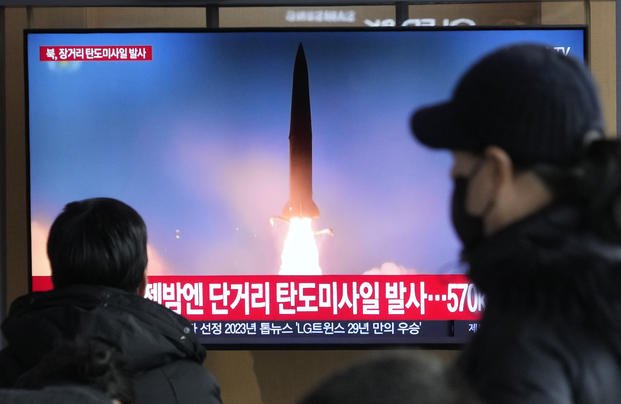SEOUL, South Korea — North Korea on Monday conducted its first intercontinental ballistic missile test in five months, likely launching a developmental, more agile weapon, as it vows strong responses against U.S. and South Korean moves to boost their nuclear deterrence plans.
The South Korean government described the missile tested as a solid-fueled weapon, a likely reference to the North’s road-mobile Hwasong-18 ICBM whose built-in solid propellants make its launch more difficult for adversaries to detect than liquid-fueled weapons. North Korean leader Kim Jong Un previously called the Hwasong-18 the most powerful weapon of his nuclear forces.
South Korea’s military said the North Korean missile flew about 1,000 kilometers (620 miles) before landing in the waters between the Korean Peninsula and Japan. It said the missile was launched on an elevated angle, an apparent attempt to avoid neighboring countries. Japanese lawmaker Masahisa Sato, citing Japan’s Defense Ministry, said the missile rose as high as 6,000 kilometers (3,730 miles).
The reported flight details matched those of North Korea’s second test of the Hwasong-18 missile in July. The North first test-fired the missile in April.
Since 2017, North Korea has carried out a slew of ICBM tests in a bid to acquire the ability to launch nuclear strikes on the U.S. mainland. But all of its previous tests before April’s Hwasong-18 launch involved liquid-propellent ICBMs, which need to be fueled before launch and cannot stay fueled for long periods.
U.S. national security adviser Jake Sullivan spoke with his South Korean and Japanese counterparts on the phone and condemned the North Korean launch as a violation of multiple U.N. Security Council resolutions that ban any ballistic activities by the North. South Korean President Yoon Suk Yeol separately ordered officials to maintain a solid South Korean-U.S. joint defense posture and respond “swiftly and overwhelmingly” to any North Korean provocations against South Korea.
The North’s ICBM test was its second weapons firing in less than a day. On Sunday night, it launched a short-range ballistic missile designed to strike South Korea that also splashed in the water off its east coast, according to its neighbors.
Observers said the back-to-back launches were likely to protest announcements by South Korea and the United States that they will bolster their joint nuclear deterrence capabilities in the face of North Korea’s evolving nuclear threats.
Senior U.S. and South Korean officials met in Washington on Friday for their second Nuclear Consultative Group meeting. They agreed to update their nuclear deterrence and contingency strategies and incorporate nuclear operation scenarios in their combined military exercises next summer, according to officials in Seoul.
The consultative body is responsible for sharing information on nuclear and strategic weapons operation plans and joint operations, though the U.S. will retain operational control of its nuclear weapons. U.S. officials said the group’s establishment and other steps to solidify U.S. security commitment were meant to ease South Korean worries about North Korean provocations while keeping Seoul from pursuing its own nuclear program.
North Korea’s Defense Ministry on Sunday called its rivals’ decision to include nuclear operation scenarios in their joint drills an open threat to potentially use nuclear weapons against the North. It said any attempt by enemies to use military force against North Korea will be met with "a preemptive and deadly counteraction.”
Park Won Gon, a professor at Seoul’s Ewha Womans University, said North Korea’s latest ICBM launch was seen as an effort to improve its military capability to attack the U.S. mainland because it views the South Korea-U.S. nuclear deterrence strategy as a security threat.
Park said the launch was also likely designed to boost Kim Jong Un's military credentials at home ahead of a key ruling party meeting next week as he appeared to lack economic achievements.
Since last year, North Korea has performed about 100 ballistic missile tests in what experts say is an attempt to enlarge its arsenal and wrest greater U.S. concessions. The U.S. and South Korea have responded by expanding their military drills and increased the temporary deployments of strategic U.S. assets such as aircraft carriers, nuclear-capable bombers and a nuclear-armed submarine in and near South Korea.
Du Hyeogn Cha, an analyst at Seoul’s Asan Institute for Policy Studies, said North Korea is expected to continue weapons testing to pressure the U.S. to change its policy on the North.
“No matter whether the Biden administration stays or steps out (of the White House) after the presidential election next year, North Korea will raise tensions on the Korean Peninsula to bring change of the U. S. government’s policy on it,” Cha said.
Animosities between the Koreas further deepened after North Korea launched its first military reconnaissance satellite into space on Nov. 21 in violation of U.N. bans. South Korea, the U.S. and Japan strongly condemned it as an attempt by the North to improve its missile technology as well as establish a space-based surveillance system.
The U.S., South Korea and Japan are pushing to put into operation the sharing of real-time missile warning data on North Korea within days, South Korea's Defense Ministry said Monday. Ministry officials said the three countries closely shared their information about Monday's launch.
Meeting with reporters in Tokyo, Adm. John Aquilino, commander of the U.S. Indo-Pacific Command, expressed concerns about North Korea's increasing missile capabilities. But he said that the United States, Japan and South Korea are working more closely than ever and that they were even ready for Monday’s launch and had mobilized their missile defense ships forward earlier this week.
“The fact that we were able to predict a launch and then posture forces in advance that was pretty, pretty impressive,” Aquilino said, adding that it was not the first time but hard to do.
Yamaguchi reported from Tokyo. Associated Press writer Jiwon Song contributed to this report.











